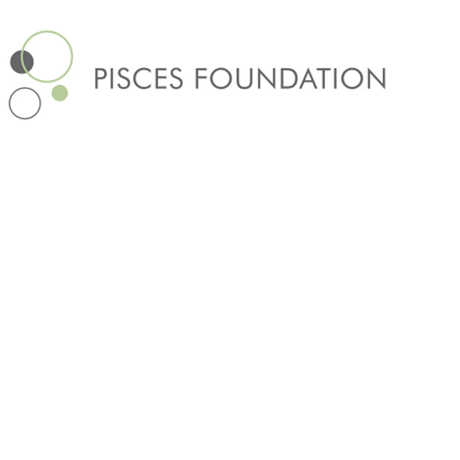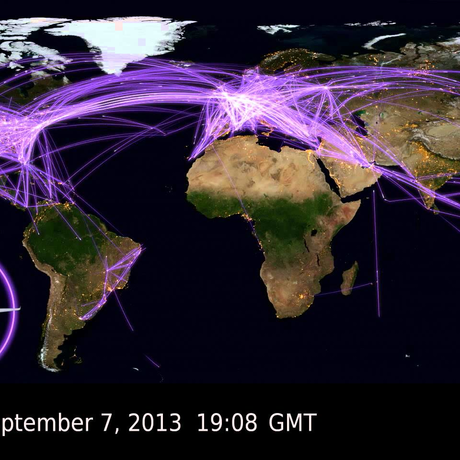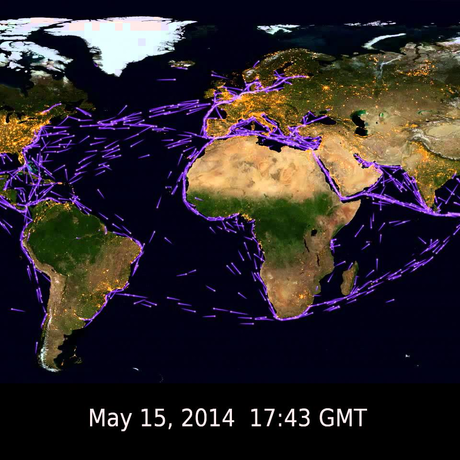Browse a rich array of educational resources from the award-winning show, Habitat Earth.
Ships cross waters in a matter of days or weeks. Shipping lanes not only connect human societies, but they also connect biological environments through which they pass—often resulting in the transport of invasive species. This clip demonstrates North American ship traffic over an eleven day period.
Exploring Invasive Species
This clip shows the movements of North American ship traffic over an 11-day period in May of 2014. A great way to use this clip in your classroom is to explore invasive species. Invasive species can migrate worldwide by being transported in the ballast water of ships. Ships from many parts of the world have traveled to the San Francisco Bay, making it the most invaded bay in the world.
You can use this clip in your classroom by asking your students to use the data presented in the clip to estimate the current rate at which invasive species enter the San Francisco Bay. This will require some outside research, estimations and calculations, and assumptions on the part of your students, and should hopefully lead to stimulating discussion about how invasive species are transported and how quickly they can spread.
Connections to Standards
Next Generation Science Standards Disciplinary Core Ideas
- LS2.A: Interdependent Relationships in Ecosystems:
- (5) Organisms can survive only in environments in which their particular needs are met. A healthy ecosystem is one in which multiple species of different types are each able to meet their needs in a relatively stable web of life. Newly introduced species can damage the balance of an ecosystem.
- (6-8) Organisms, and populations of organisms, are dependent on their environmental interactions both with other living things and with nonliving factors.
- (6-8) In any ecosystem, organisms and populations with similar requirements for food, water, oxygen, or other resources may compete with each other for limited resources, access to which consequently constrains their growth and reproduction. Predatory interactions may reduce the number of organisms or eliminate whole populations of organisms.
- LS2.C: Ecosystem Dynamics, Functioning, and Resilience:
- (6-8) Biodiversity describes the variety of species found in Earth’s terrestrial and oceanic ecosystems. The completeness or integrity of an ecosystem’s biodiversity is often used as a measure of its health.
- (9-12) Anthropogenic changes (induced by human activity) in the environment--including habitat destruction, pollution, introduction of invasive species, overexploitation, and climate change-- can disrupt an ecosystem and threaten the survival of some species.
- LS4.D: Biodiversity and Humans:
- (6-8) Changes in biodiversity can influence humans' resources, such as food, energy, and medicines, as well as ecosystem services that humans rely on.
- (9-12) Humans depend on the living world for the resources and other benefits provided by biodiversity. But human activity is also having adverse impacts on biodiversity through overpopulation, overexploitation, habitat destruction, pollution, introduction of invasive species, and climate change. Thus sustaining biodiversity so that ecosystem functioning and productivity are maintained is essential to supporting and enhancing life on Earth. Sustaining biodiversity also aids humanity by preserving landscapes of recreational or inspirational value.
- ESS2.A: Earth Materials and Systems:
- (5) The ocean supports a variety of ecosystems and organisms, shapes landforms, and influences climate.
- (5) The ocean supports a variety of ecosystems and organisms, shapes landforms, and influences climate.
- ESS3.C: Human Impacts on Earth Systems:
- (5) Human activities in agriculture, industry, and everyday life have had major effects on the land, vegetation, streams, ocean, air, and even outer space. But individuals and communities are doing things to help protect Earth's resources and environments.
- (6-8) Typically as human populations and per-capita consumption of natural resources increase, so do the negative impacts on Earth unless the activities and technologies involved are engineered otherwise.
- (9-12) Scientists and engineers can make major contributions by developing technologies that produce less pollution and waste and that preclude ecosystem degradation.
California Environmental Principles and Concepts
- Principle IV: The exchange of matter between natural systems and human societies affects the long-term functioning of both.
- Concept b: Students need to know that the byproducts of human activity are not readily prevented from entering natural systems and may be beneficial, neutral, or detrimental in their effect.
How Have Teachers Used this Video Clip?

"How Quickly do Ships Cross the Ocean and How Many Planes Are in the Sky are great videos to show modern transportation. Students get a great visual on human impact by seeing all of those lights and what they represent. The habitat earth video is a great overview that ties in many subjects and provides a scaffold for students to build content on." -6th Grade Science Teacher from Stockton, CA
"Before direct teaching of AP environmental science curriculum, I commonly set-up a leaning unit through a current event video or collaborative learning method. These materials offer options to integrate into learning units that keep the content current and relevant." -High School Environmental and Physical Science Teacher from San Jose, CA
Have an idea you'd like us to post on this page? Email us.
Visualizations based on aggregated data provide the unique opportunity to engage your students in various Science Practices highlighted in the Next Generation Science Standards, including asking questions, analyzing and interpreting data, and constructing explanations. As an example, Academy educators developed sample activities such as this one and this one.
From KQED: An Invaded Estuary
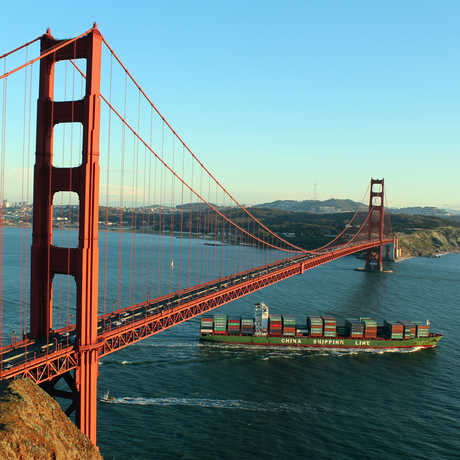
These lessons use short video clips to teach students (grades 6-8 and 9-12) about alterations in the San Francisco Bay ecosystems that have resulted from the increased numbers of invasive species and what is being done to prevent more invasive species from getting into the bay. (Photo: © Joan Campderrós-i-Canas)
From U.S. Fish and Wildlife Service: Wild Things
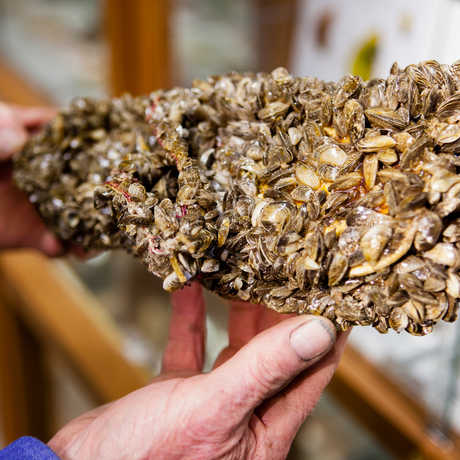
This educator’s guide (grades 6-8 and 9-12) includes four different lessons for students on invasive species, from defining what an invasive species is, to identifying the effects of invasive species on ecosystems. Students will also learn about steps the U.S. Fish and Wildlife Service is taking to control invasive species and what they can do to help. (Photo: © Chesapeake Bay Program)
NOAA: The Lionfish Invasion!
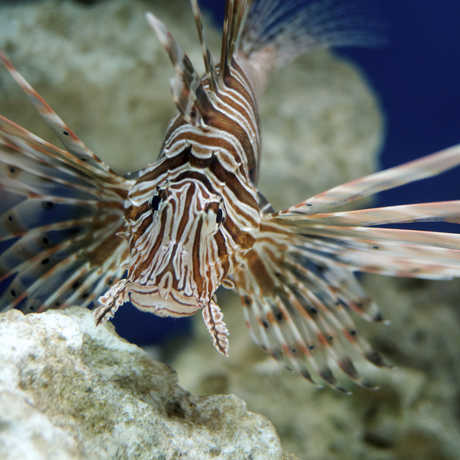
This website includes a list of ideas on how to bring the lionfish and other invasive species of the Atlantic Ocean into the classroom.(Photo: © Oliver Quinlan)
Related article: Academy research tracking lionfish
Related video: Invasive Lionfish
Recommended Resources
Invasion of an Exotic Species: Stop the Zebra Mussel!
This website from the Virginia Sea Grant Marine Advisory Program includes several activities and resources to teach students (grades 8-12) about the invasive zebra mussel.
KQED Quest: San Francisco Bay Invaders
How do exotic species impact native species, and why is it a big deal if exotics enter our bay and change the ecosystem? Explore these and other questions with students of all ages after watching a short (~10 minute) video clip.
Turtle hybrids
The Academy's Brian Simison looks at the response of native species to competition in their native ecosystem by investigating how invasive species’ DNA affects that of native species.
Fishy Controversy
Will invasive Asian carp cause problems for native species living in the Great Lakes? Read about the controversy here.
Visualizing Global Travel
Read how visual effects artist Erik Krumrey used computer graphics to make data come to life in Habitat Earth.
Preventing Whale Ship Strikes
How do whales respond to an oncoming ship? The answer could provide insight into reducing ship strikes in the future.
Shipping Lane Changes
Learn how extended shipping lanes into the San Francisco Bay could reduce vessel strikes with whales.
Sounds of the Sea: Shipping
What does a tanker ship sound like from underwater? Listen here!
Fighting Invasive Species
Read about how some scientists are proposing an invasive species 'Black List' as a way to monitor alien species and prioritize conservation measures.
NOAA: Alien Invasion!
What are invasive species, why are they a problem, and what can be done about them? Explore these questions with your students in this lesson designed for grades 9-12.
Sea Grant Great Lakes Network: The Great Lakes Invasion
This informative curriculum guide is a one-stop shop for aquatic invasive species education, covering everything from what invasive species are and how they were introduced to individual profiles on specific invaders.
Oregon State Sea Grant: Design the Ultimate Invader
In this lesson (for grades 9-12, but adaptable for other grade levels), students apply their current knowledge of biology and ecology to design and critically evaluate the ultimate invasive species.
Weed Invasion
This curriculum is for teachers who want to integrate the topic of invasive weeds into their classroom.
The New York Times Learning Network: Nature's Invaders: Exploring the Effects of Invasive Species on Local Ecosystems
What are invasive species, and how do they affect ecosystems? In this lesson, students learn how an invasive species and a native species experiencing a population explosion may threaten some of the world’s oldest trees, bristlecone pines in the Western United States.
NOVA: Invasive Species Matching Game
Students can learn more about invasive species in this interactive matching game.
National Teacher Training Institute: Battlefield Earth
Engage your students and introduce them to the dilemma of deadly invaders using games and media.
Canadian Museum of Nature: The Invaders
Explore how invasive species like the zebra mussel can impact biodiversity in Canada’s rivers.
National Geographic: Aquatic Invaders
In this activity designed for grades 6-8, students will discover how the various elements of the Chesapeake Bay ecosystem are interconnected and investigate some of the issues associated with invasive species.
Share This
Learn the benefit of using videos in the classroom, and browse resources to help you get started.
Our collection of educational videos will help your students visualize data and understand scientific concepts.
Environmental Literacy Initiative, major funding provided by
